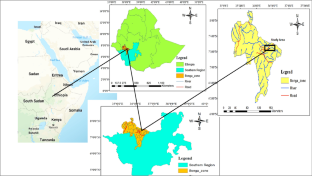Environmental Earth Sciences ( IF 2.8 ) Pub Date : 2024-04-10 , DOI: 10.1007/s12665-024-11545-x Damtew Tsige Melese , Ayalew Talema Legas

|
The instability of slopes along road corridors is often controlled by planting tree species on the surface of the slopes. However, the effectiveness of tree-based slope stabilization has not been investigated in the sub-humid tropics, Ethiopia. This study aims to explore the effectiveness of Rhamnus prinoides and Psidium guajava on road cut slope rehabilitation. The roots of Rhamnus prinoides and Psidium guajava are studied by excavating the whole root system along the crown diameter. Root area ratio (RAR) values are determined by counting roots per 0.2 m soil depth. Single root specimens are sampled and tested for tensile strength (Tr) at different root topographic feature, with different diameter classes. Root cohesion (Cr) is determined from RAR and Tr values by using a mathematical model. The maximum values of RAR are located within the range of 0.2–0.6 m soil depth. With the maximum depth of 2.2 m, Rhamnus prinoides provided the maximum cohesion value (9.9 kpa) than Psidium guajava, which indicates its effective soil reinforcement capacity. Results from root tensile testing revealed that root traits and diameter had significant influence on tensile strength of tree roots. Root diameter had strong negative correlation with tensile strength. In conclusion, the planting of Rhamnus prinoides and Psidium guajava tree species has multiple positive effects on hill slope rehabilitation, including soil erosion control, water retention, biodiversity promotion, carbon sequestration. Their inclusion in hill slope rehabilitation programs can contribute to the overall ecological restoration and sustainability of such areas.
中文翻译:

山坡修复用鼠李和番石榴树种
道路走廊沿线边坡的不稳定通常通过在边坡表面种植树种来控制。然而,在埃塞俄比亚的半湿润热带地区,基于树木的边坡稳定的有效性尚未得到研究。本研究旨在探讨鼠李和番石榴在路堑边坡修复中的有效性。通过沿着树冠直径挖掘整个根系来研究鼠李糖和番石榴的根。根面积比 (RAR) 值通过计算每 0.2 m 土壤深度的根数来确定。对单根样本进行取样并测试不同根部地形特征、不同直径等级的拉伸强度 ( Tr )。根内聚力 (Cr) 是使用数学模型根据 RAR 和Tr值确定的。 RAR的最大值位于0.2~0.6 m土深范围内。鼠李糖在最大深度为2.2 m时,比番石榴提供了最大的粘聚力值(9.9 kpa),表明其有效的固土能力。根部抗拉试验结果表明,根系性状和直径对树根的抗拉强度有显着影响。根径与抗拉强度呈强负相关。综上所述,种植鼠李树和番石榴树种对山坡修复具有控制水土流失、保持水分、促进生物多样性、固碳等多种积极作用。将它们纳入山坡恢复计划有助于这些地区的整体生态恢复和可持续性。



























 京公网安备 11010802027423号
京公网安备 11010802027423号